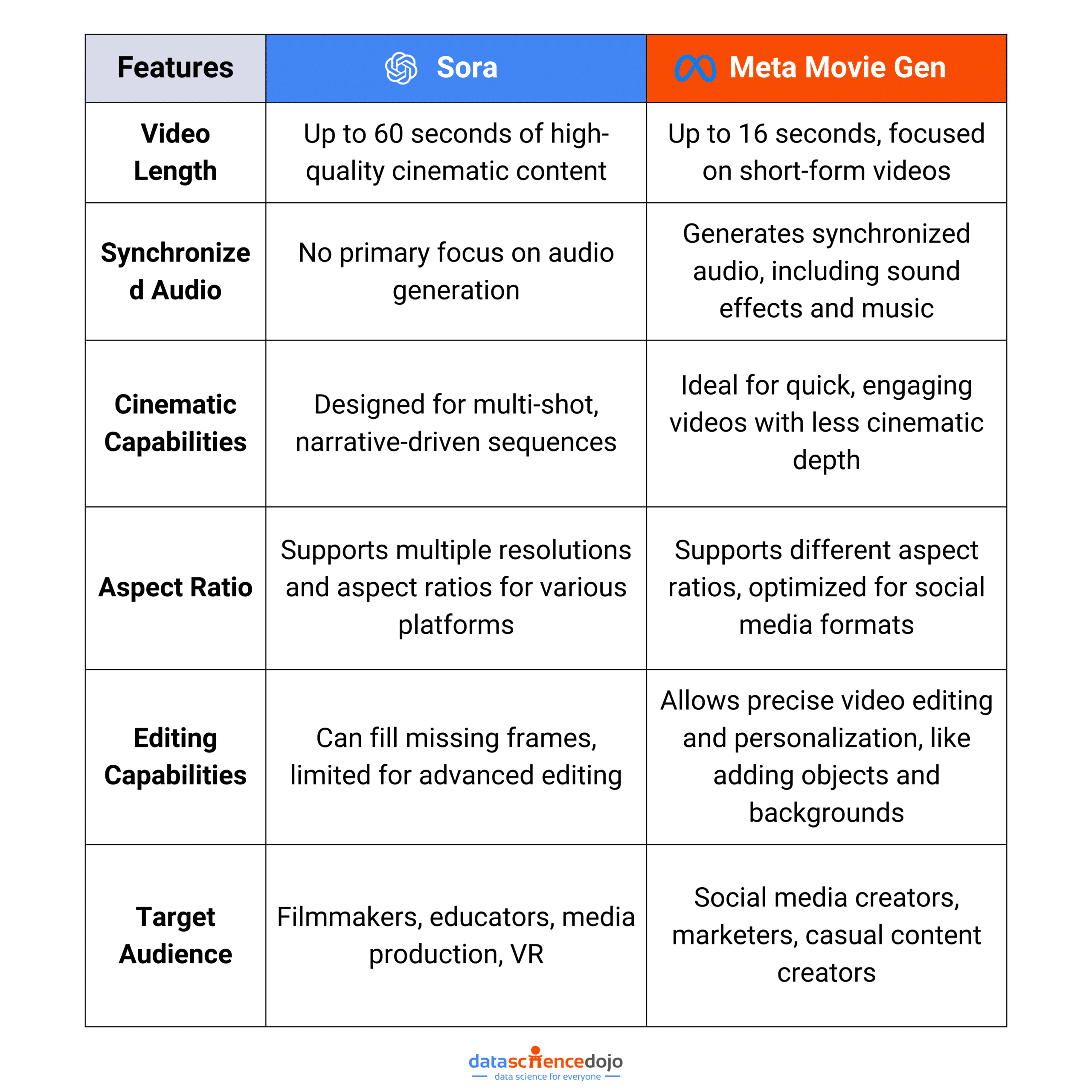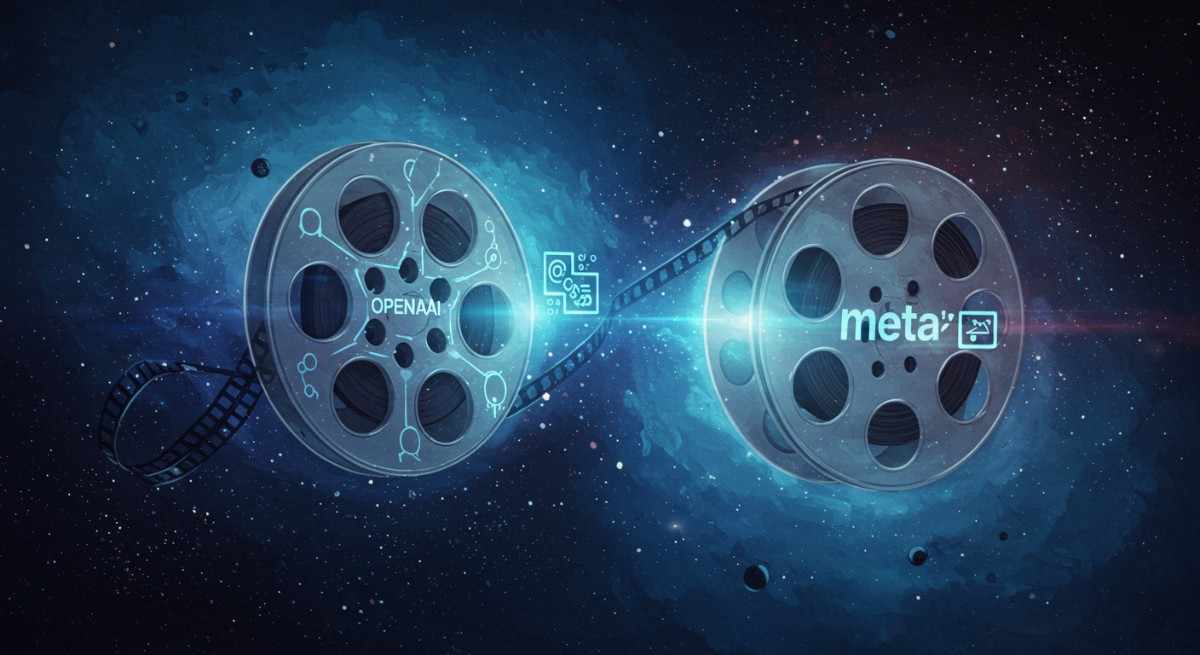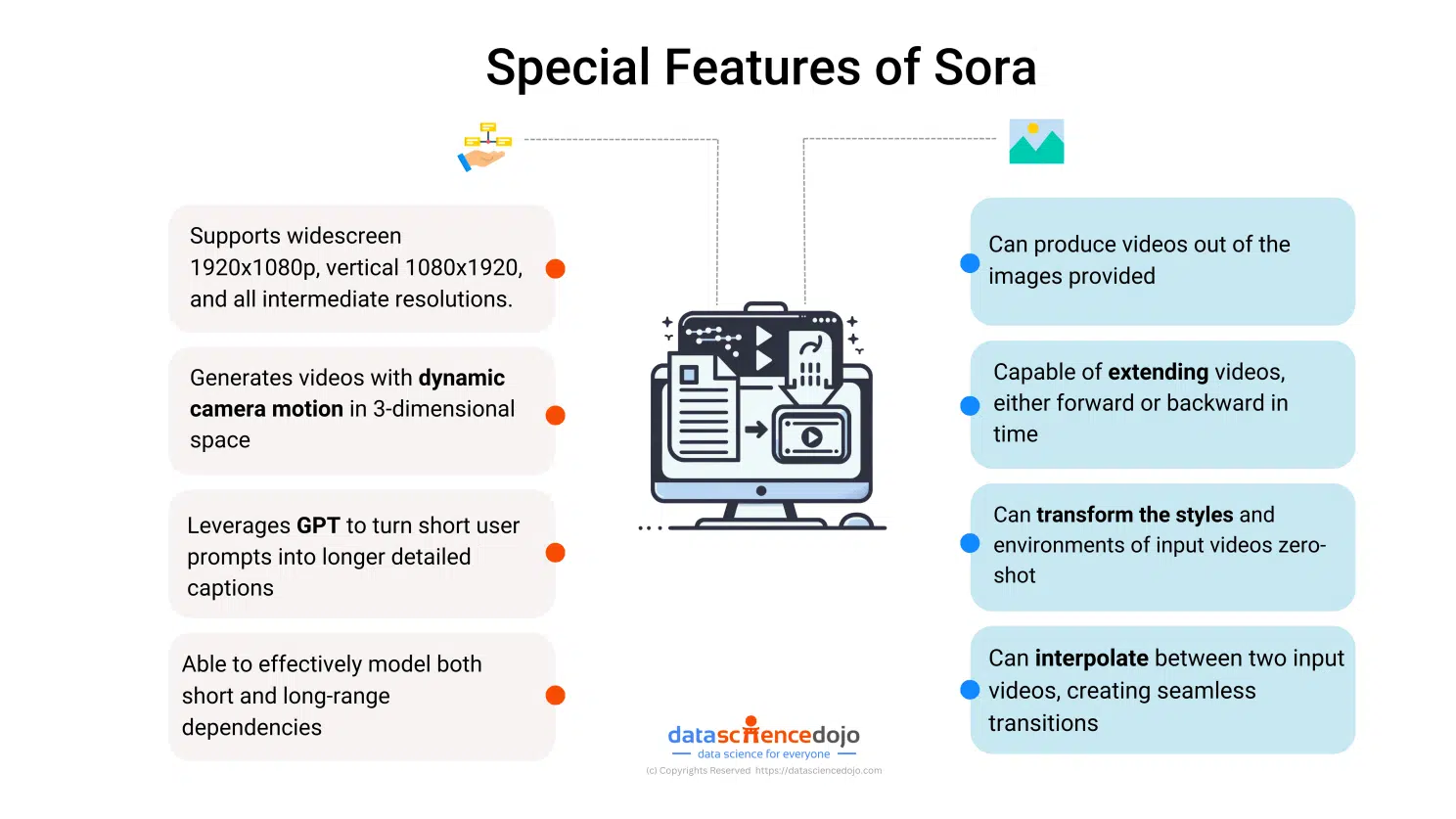What started as a race to dominate language models with GPT and LLaMA is now moving into a new dimension: video.
OpenAI and Meta, two of the biggest names in AI, are taking their competition beyond text and images into the realm of video generation. OpenAI’s Sora AI and Meta’s Movie Gen are leading this shift, offering the power to create entire scenes with just a few words.
While Meta’s Movie Gen has begun with short-form videos designed for social media, it’s clear that their ambitions extend beyond this. On the other hand, OpenAI’s Sora is already exploring rich, cinematic video generation, capable of producing multi-shot, narrative-driven sequences that echo the look and feel of traditional filmmaking.
This next phase in AI-driven creativity promises to reshape industries, from social media to Hollywood, as the race to dominate AI-generated video heats up. In this blog, we will compare and contrast both of these emerging models and see how they can set the stage for something completely different!
let’s dig in!
What is Meta Movie Gen?
Meta’s Movie Gen is an advanced AI model designed to create high-definition videos from text prompts or existing footage. This model not only generates realistic video clips but also adds synchronized audio, including sound effects and background music.
Capabilities of Meta Movie Generation
Meta’s Movie Gen has several advanced capabilities:
-
High-Quality Video Generation: Movie Gen can generate high-definition videos up to 16 seconds long from text prompts, achieving state-of-the-art results in video quality.
-
Synchronized Audio Generation: The model also generates synchronized audio, including sound effects and background music that match the visual content. This includes diegetic sounds (sounds that are part of the film’s world) and non-diegetic music (background music to support the mood).
-
Video Editing: Movie Gen can perform precise video editing based on user instructions. It allows for changes such as adding objects, modifying textures, and changing backgrounds in existing videos
-
Personalized Video Generation: The model can create personalized videos by incorporating a user’s image into the video, maintaining the identity of the person while following the text prompt.
-
Multi-Aspect Ratio Generation: Movie Gen supports generating videos in different aspect ratios, which is useful for various platforms and media requirements.
These capabilities make Movie Gen a powerful tool for creating, editing, and personalizing videos with synchronized audio for diverse applications.
Explore key prompting techniques to use with AI video generators
How does Meta Movie Gen Work?
Meta Movie Gen works by using flow matching, a technique related to diffusion. The system is trained to remove noise from images and videos using matching text descriptions. It was trained on 1 billion image-text pairs and 100 million video-text pairs. At inference, the model starts with random noise and generates detailed imagery based on a text prompt.
To improve performance, Movie Gen Video combines multiple text embeddings:
-
UL2 embeddings provide reasoning abilities by being trained on text-only data.
-
MetaCLIP embeddings help with cross-modal generation, aligning text and image representations.
-
ByT5 embeddings capture individual text elements like letters and numbers used when a prompt requests specific text within the generated video.
This combination allows for more accurate and diverse video generation across a range of inputs.
Read in detail about embeddings
Current Status and Availability of Meta Video Gen
Meta’s Movie Gen is currently in the experimental phase and has not yet been widely released to the public. While Meta has demonstrated the model’s capabilities and shared some early use cases, it is still undergoing development and refinement. The company has not provided a specific release date for public access, but it is expected that Movie Gen will eventually be integrated into Meta’s social platforms like Facebook, Instagram, and WhatsApp.
What is Sora AI?
Sora is OpenAI’s text-to-video generative AI model. It can create videos from scratch, extend existing videos, or fill in missing frames from videos.
Sora was first announced in February 2024, and since then, it has been limited to a small group of creators due to concerns over time to generate, cost, and the potential for misinformation.
Read more about Sora AI
The model has been praised for its character consistency and realistic motion, although it also faces challenges with complex human movement and motion inconsistencies.
What was the Training Process of Sora AI?
Sora AI is trained using a diffusion-based model, where random noise is added to video frames, and the model learns to denoise and recover the original data. This technique enables the generation of high-quality videos from text prompts.
The model processes visual data through spatio-temporal patches, allowing it to learn both spatial and temporal relationships in the video sequences, enhancing the coherence and realism of the generated content.
The training process also includes re-captioning techniques, where detailed captions are generated for videos using models like GPT, which improves Sora’s understanding of diverse prompts. Additionally, Sora uses a latent space compression network to reduce the complexity of video data during training and generation, making it more efficient.
The model is trained on a mix of public and licensed video datasets, with safety guidelines in place to prevent the generation of harmful or misleading content. OpenAI also incorporates C2PA metadata to tag generated videos, ensuring transparency about their AI origin.
Capabilities of Sora AI
-
Text-to-Video Generation: Sora generates high-quality, minute-long videos from text prompts, creating detailed and realistic video scenes that align closely with the given input. This capability includes the ability to interpret natural language and generate sequences of shots and angles without direct instruction.
-
Variable Resolution and Aspect Ratios: Sora can generate videos in multiple resolutions and aspect ratios, making it flexible for various platforms such as widescreen or vertical formats. This adaptability makes it ideal for different content needs, from cinematic videos to social media clips.
-
Multi-Shot Cinematic Sequences: The model has the ability to create multiple shots in a single generated video, preserving character consistency and visual style across different camera angles. This allows for a more cinematic approach to video generation.
-
Flexibility in Video Output: Sora can rapidly prototype lower-resolution video before scaling up to full resolution, making it efficient for content creators who need to preview before rendering the final output.
Feature-by-Feature Comparison: Sora AI vs. Meta Movie Gen

1. Video Length
-
Sora AI can generate videos up to 60 seconds in length, making it suitable for longer, more cinematic content.
-
Meta Movie Gen is limited to creating clips up to 16 seconds long, focusing more on short-form, quick-consumption content.
2. Synchronized Audio
-
Sora AI does not primarily focus on synchronized audio, as its main strength lies in video generation.
-
Meta Movie Gen excels in this area by generating synchronized audio, including sound effects and background music, that match the visual content seamlessly.
3. Cinematic Capabilities
-
Sora AI is designed to create narrative-driven, multi-shot sequences with dynamic camera angles and consistent characters, making it ideal for more complex storytelling.
-
Meta Movie Gen is more suited to short-form content that focuses on social engagement, with less emphasis on complex cinematic sequences.
Here’s a list of 10 must-watch AI movies
4. Resolution & Aspect Ratio
-
Sora AI supports multiple resolutions and aspect ratios, making it adaptable to different platforms and use cases, such as widescreen and vertical formats.
-
Meta Movie Gen also supports different aspect ratios, but its primary focus is on generating content that fits social media platforms like Instagram and Facebook.
5. Editing Capabilities
-
Sora AI is primarily focused on generating video content and can enhance missing frames, but it’s not designed for detailed video editing.
-
Meta Movie Gen allows for more detailed editing, enabling users to modify backgrounds, add objects, and personalize the video content as per user instructions.
6. Personalization
-
Sora AI generates generalized content based on user prompts without personalization features.
-
Meta Movie Gen offers personalized video generation by incorporating user images into the video, maintaining the identity of the person throughout the generated content.
Learn more about AI-driven personalization
7. Applications
-
Sora AI is ideal for media production, virtual reality, education, and gaming, where cinematic quality and complex storylines are required.
-
Meta Movie Gen is designed for content creators and marketers, especially those looking to generate quick, engaging videos for social media platforms.
8. Strengths
-
Sora AI shines in creating rich, narrative-driven content with cinematic depth and multi-shot sequences.
-
Meta Movie Gen is optimized for creating short, engaging social media content with synchronized audio and personalized elements.
9. Limitations
-
Sora AI struggles with simulating complex physical interactions and handling spatial inaccuracies, such as left-right distinctions.
-
Meta Movie Gen is limited to shorter clips and does not offer the same cinematic depth as Sora AI, focusing more on social media-driven content.
All in all, Sora AI is well-suited for cinematic, narrative-rich video creation, while Meta Movie Gen is designed for short, social-media-focused content with audio integration and personalization. Both models cater to different needs and use cases.
What can you Expect from Sora AI and Meta Movie Gen?
Both Sora AI and Meta Movie Gen are still in their experimental phases, yet they represent the next wave of innovation in video generation. Sora AI is pushing the boundaries of cinematic storytelling with its ability to produce long-form, narrative-driven videos, while Meta Movie Gen is set to revolutionize short-form content creation with its personalized, sound-integrated clips.
At this point, neither model is publicly available, so the decision of which to use will have to wait until they are fully launched. However, their future potential is clear: Sora AI is poised to serve filmmakers, educators, and content creators who need cinematic depth, whereas Meta Movie Gen will likely dominate social media platforms, offering a more casual, engaging way to generate video content.
As both models continue to evolve, their availability will open up new opportunities for creators across industries. Stay tuned for updates and prepare to explore these powerful tools when they become available!







